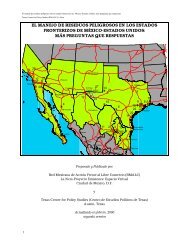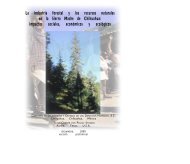Pesticides and Water Quality - Texas Center for Policy Studies
Pesticides and Water Quality - Texas Center for Policy Studies
Pesticides and Water Quality - Texas Center for Policy Studies
Create successful ePaper yourself
Turn your PDF publications into a flip-book with our unique Google optimized e-Paper software.
Red River BasinThere has been no systematic monitoring <strong>for</strong> non-point source pollution in this basin. Potential sources<strong>for</strong> non-point source pollution are cities, industries, agriculture, silviculture <strong>and</strong> on-site wastewater. The1994 Assessment Report recommended that non-point source pollution <strong>and</strong> attendant monitoring remain ahigh priority <strong>for</strong> the basin. 71The 1996 Assessment states: “There has been …limited monitoring of herbicides, pesticides <strong>and</strong> PCB’s inthe Red River Basin over the past 30 years. Although cultivation of food <strong>and</strong> fiber crops occurs in manyparts of the basin, there are insufficient water quality data available in the TNRCC records on chemicalsused in crop production to make an assessment using the screening criteria.” 72Rio Gr<strong>and</strong>e River BasinFor the purposes of this report, the authors paid special attention to the 1996 Regional Assessment of<strong>Water</strong> <strong>Quality</strong> in the Rio Gr<strong>and</strong>e River Basin. This 1996 Assessment stated that little in<strong>for</strong>mation existson toxic substances, particularly pesticides <strong>and</strong> heavy metals. The study further stated that in<strong>for</strong>mationabout types of l<strong>and</strong> use, pesticide use, population growth, soil conditions, climate <strong>and</strong> other factors thatinfluence water quality must also be compiled. 73 The Rio Gr<strong>and</strong>e Basin study pointed out that in theArroyo Colorado upstream of the Port of Harlingen, the <strong>Texas</strong> Department of Health has advised peoplenot to consume any fish from the waters. The Health Department is concerned with the presence of thepesticides DDE, toxaphene <strong>and</strong> chlordane. Use of all three of these pesticides have been banned in theU.S., but persist in the environment. 74 In addition to the analysis of fish tissue, biological methods wereused to assess toxicity levels in the river system. According to the study, “the occurrence of pesticides ismore widespread. Seven different pesticides (out of 50 tested) exceeded criteria at about a third of thesites. [DDT, lindane, dieldrin, DDE, chlordane, chlorpyrifos, diazinon]. The most frequent occurrenceswere in the Lower Rio Gr<strong>and</strong>e Valley, an intensively farmed area, <strong>and</strong> in the Laredo/Nuevo Laredo area.Three of these pesticides are (or were) used <strong>for</strong> home <strong>and</strong> garden use, suggesting urban as well asagricultural sources." 75Sabine River BasinThe 1994 Assessment <strong>for</strong> the Sabine River Basin found a possible pesticide concern (<strong>for</strong> malathion) inone segment out of 14 total segments. However, the Report stated that “this should not be taken to meanthat there are no problems with organics in the Sabine Basin, it is simply a reflection of the fact that welack sufficient data to assess the situation.” 76 In the 1996 Assessment, preliminary results indicatedambient toxicity in one segment, <strong>and</strong> pesticides were identified as a possible cause. One of therecommendations of the Assessment report was that the Sabine River Authority sub-watershed inventoryshould continue collecting additional in<strong>for</strong>mation on l<strong>and</strong> use <strong>and</strong> other activities which can influencewater quality. 7771 Red River Authority, Red River Basin <strong>Water</strong> <strong>Quality</strong> Assessment (Wichita Falls: Red River Authority, 1994), 3-40.72 Red River Authority, Red River Authority of <strong>Texas</strong> Regional Assessment (Wichita Falls: RRA, 1996), 85.73 <strong>Texas</strong> Natural Resource Conservation Commission, 1996 Regional Assessment of <strong>Water</strong> <strong>Quality</strong> in the Rio Gr<strong>and</strong>e Basin(Austin: TNRCC, 1996), 6.74 Ibid., 30.75 Ibid., 41.76 Sabine River Authority, Sabine River Basin Assessment of <strong>Water</strong> <strong>Quality</strong> (Orange: Sabine River Authority, 1994), 41.77 Sabine River Authority, Sabine River Basin Assessment of <strong>Water</strong> <strong>Quality</strong> (Orange: SRA, 1996), 7.27




